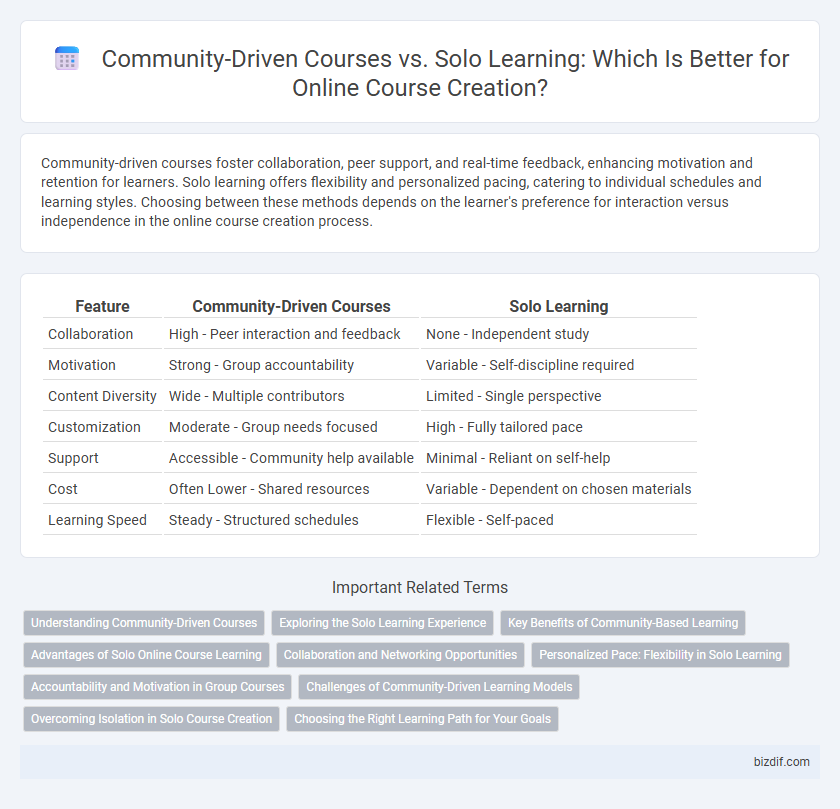Community-driven courses foster collaboration, peer support, and real-time feedback, enhancing motivation and retention for learners. Solo learning offers flexibility and personalized pacing, catering to individual schedules and learning styles. Choosing between these methods depends on the learner's preference for interaction versus independence in the online course creation process.
Table of Comparison
| Feature | Community-Driven Courses | Solo Learning |
|---|---|---|
| Collaboration | High - Peer interaction and feedback | None - Independent study |
| Motivation | Strong - Group accountability | Variable - Self-discipline required |
| Content Diversity | Wide - Multiple contributors | Limited - Single perspective |
| Customization | Moderate - Group needs focused | High - Fully tailored pace |
| Support | Accessible - Community help available | Minimal - Reliant on self-help |
| Cost | Often Lower - Shared resources | Variable - Dependent on chosen materials |
| Learning Speed | Steady - Structured schedules | Flexible - Self-paced |
Understanding Community-Driven Courses
Community-driven courses leverage collaborative learning by engaging diverse participants who contribute unique perspectives and real-time feedback, enhancing comprehension and retention. Peer interaction in these courses fosters motivation and accountability, often leading to higher completion rates compared to solo learning. Platforms like Coursera and Udemy increasingly incorporate community features to support this interactive educational model, emphasizing collective knowledge building.
Exploring the Solo Learning Experience
Solo learning in online course creation offers personalized pacing and deep self-reflection, enabling learners to tailor content to their unique needs. This approach fosters independent problem-solving skills and intrinsic motivation without relying on group dynamics. Emphasizing autonomy, solo learning empowers individuals to master complex topics through focused, uninterrupted study sessions.
Key Benefits of Community-Based Learning
Community-driven courses foster collaboration and peer support, leading to enhanced motivation and deeper understanding through diverse perspectives. Active engagement with peers enables real-time feedback and networking opportunities that boost retention and practical application of knowledge. This interactive learning environment promotes accountability and shared goals, accelerating skill development compared to solo learning.
Advantages of Solo Online Course Learning
Solo online course learning allows for complete flexibility in pacing and content focus, enabling learners to tailor their experience to individual goals and schedules. This method enhances self-discipline and independent problem-solving skills by encouraging learners to explore materials and resources autonomously. Cost efficiency and accessibility also improve as learners avoid group-related expenses and constraints, facilitating studies anytime and anywhere.
Collaboration and Networking Opportunities
Community-driven courses foster collaboration and networking opportunities that significantly enhance learning experiences by enabling peer feedback, group projects, and real-time discussions. Solo learning lacks these interactive elements, often resulting in limited exposure to diverse perspectives and fewer chances to build professional connections. Leveraging community engagement in online course creation boosts motivation, knowledge retention, and access to industry-relevant networks.
Personalized Pace: Flexibility in Solo Learning
Solo learning empowers students to progress at a personalized pace, allowing customization of study schedules and content absorption based on individual understanding and speed. This flexibility supports diverse learning styles and helps accommodate varying time commitments, enhancing knowledge retention. Personalized pacing in solo learning contrasts with community-driven courses, where progress may depend on group timelines and collaborative activities.
Accountability and Motivation in Group Courses
Community-driven online courses significantly enhance accountability and motivation by fostering peer support and collaborative learning environments. Participants in group courses benefit from shared goals, regular feedback, and the social pressure to stay committed, which reduces dropout rates compared to solo learning. These dynamics create a structured and engaging educational experience that promotes consistent progress and higher completion rates.
Challenges of Community-Driven Learning Models
Community-driven courses face challenges such as coordinating diverse learner schedules, maintaining consistent engagement, and managing differing skill levels within groups. Facilitators must address conflicting opinions and ensure effective communication to prevent misunderstandings that hinder progress. These difficulties require robust support systems and adaptive instructional design to sustain motivation and achieve learning outcomes.
Overcoming Isolation in Solo Course Creation
Community-driven courses foster collaboration and peer support, reducing feelings of isolation common in solo course creation. Engaging with a learning community enhances motivation and provides real-time feedback, accelerating skill development. Solo learners often struggle with accountability and limited interaction, which can hinder consistent progress and course quality.
Choosing the Right Learning Path for Your Goals
Community-driven courses offer interactive forums, peer feedback, and collaborative projects that enhance motivation and deeper understanding through shared experiences. Solo learning provides flexibility and personalized pacing, ideal for self-disciplined learners seeking tailored content without external dependencies. Selecting the right learning path depends on your goals, preference for social interaction, and commitment to structured engagement versus autonomous study.
Community-driven courses vs Solo learning Infographic

 bizdif.com
bizdif.com